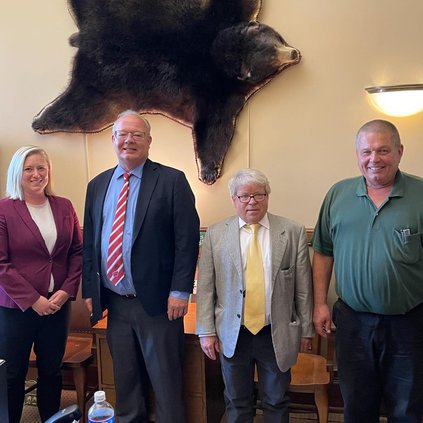MADISON – Rep. Todd Novak (R-Dodgeville), Memorial Hospital of Lafayette County COO Molly Wiegel, Dr. Martin Cleary and Lafayette County Hospital Committee member Jed Gant were all present to testify before the Assembly State Affairs Committee in favor of Assembly Bill 390, authored by Novak, Rep. Travis Tranel (R-Cuba City), and Rep. Tony Kurtz (R-Wonewoc). The bill is asking to direct $4 million of the federal American Rescue Plan Act funds to MHLC for facility planning expansion and construction.
The bill also asked to direct $11 million in grants to support emergency medical services over a two-year period and to award $400,000 in grants for improvements to the city of Reedsburg community center.
The American Rescue Plan Act of 2021 is a $1.9 trillion economic stimulus bill passed in March 2021 to assist in the United States’ recovery from the economic and health effects of COVID-19. It provides funding for several areas such as child care, schools, agriculture, mental health, science research and development, COVID-19 testing, treatment, and prevention, tribal government services, and health care providers in rural areas.
Wiegel shared background information on MHLC’s current project and how they came to the point they are today. She touched on the economic impact the hospital has on the county and requested assistance in the further research needed for the project.
Gant gave the committee a history of MHLC and the county structure. Dr. Cleary shared his experiences with providing care in an older facility and tied it to COVID patients and how a new facility would have assisted MHLC better. The committee was very moved by Dr. Cleary’s words and thanked him for “painting a picture of what it was like (during COVID) to care for patients”.
“I sincerely thank each of you for taking the time to consider how Bill 390 will significantly and positively impact the future of Memorial Hospital of Lafayette County, as well as the nearly 150 employees whom we feel blessed to have working on behalf of over 16,600 residents,” MHLC CEO Kathy Kuepers wrote to the committee.
Kuepers addressed how not only will the $4 million grant to MHLC help the hospital in their replacement facility planning process but also the $5.5 million in grants in fiscal year 2021-22 and another $5.5 million in grants in fiscal year 2022-23 to support emergency medical services will also significantly and positively impact Lafayette County due to the newly formed and critically important EMS department.
“The funding provision in Bill 390 will help us deliver on our promise to provide exceptional patient care in an environment that is safe for our physicians, nurses, and all those who provide direct and indirect patient care. The provision for emergency medical services will also provide us with much-needed infusion of financial support for our first, county-owned EMS department, which directly responds to Lafayette County on the verge of losing this service altogether,” Kuepers wrote.
The service is ready to go live on July 1.
The request for funds is to cover the expenses not covered by the actual construction project, Wiegel explained. It will be used for the research portion of the project.
Rep. Novak joined with Kurtz and Tranel to “identify the items directly affecting our southwest Wisconsin districts and had those items included in a clean standalone piece of legislation.”
“The need to upgrade or replace the hospital is real,” Novak stated in an email to the Republican Journal. “MHLC notes that closing their facility would result in an even higher risk to individuals in the area suffering negative health outcomes.”
Novak added that rural EMS are struggling and this bill would make a real difference to help settle a variety of expenses like medical equipment and tools, safety devices and radios.
“As a state representative, I'm always looking for ways the state can assist communities & counties in the 51st Assembly District,” Novak stated. “I see so much money directed to urban areas that I think it is important to fight for rural Wisconsin.
On Tuesday, June 15, the billed passed the Assembly State Affairs Committee and will now be taken up on the full Assembly floor.









